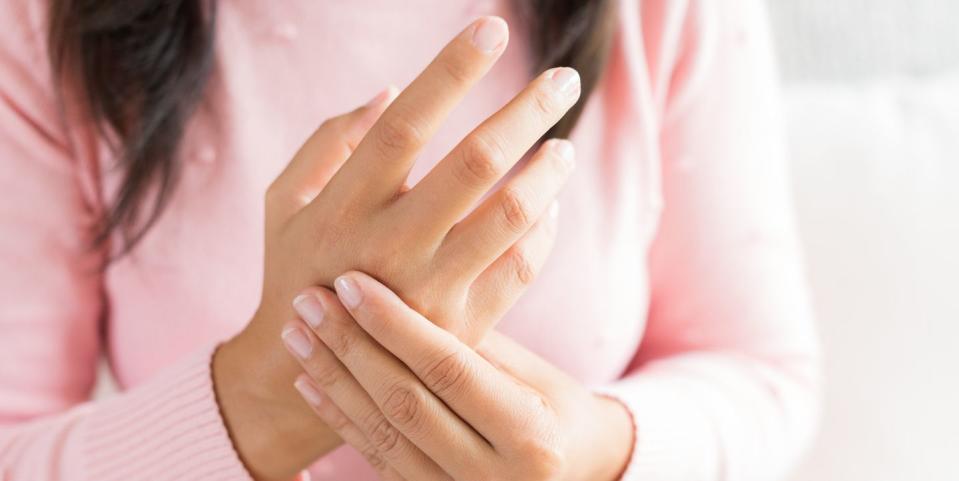How Arthritis Patients Fight Pain When They’re Having a Flare

"Hearst Magazines and Yahoo may earn commission or revenue on some items through the links below."
When you have rheumatoid arthritis (RA)—an autoimmune disease that causes joint pain, stiffness, swelling, and chronic fatigue—there’s a good chance you field a lot of advice from friends, family, and strangers about how to ease your discomfort. While the people doling out their best tips may mean well, it’s impossible for them to really understand the symptoms you’re experiencing, or what will make you feel better.
The exception? Other RA patients. That’s why we asked three women who’ve dealt with painful arthritis symptoms for years to share what helps them find some relief. Here’s hoping one or more of their tips will work for you, too.
Editor’s note: Check with your doctor before trying any new treatments for your RA pain.
Lisa Emrich, 52, Falls Church, Virginia

The vague symptoms started when Emrich was in her twenties: achiness, stiffness, and lack of coordination in her hands. She didn’t understand what was happening and neither did her doctors. One misdiagnosed her with carpal tunnel syndrome. Another thought she was being dramatic and told her not to worry about it.
“I’m a musician, so these symptoms were really troublesome,” says Emrich. “At night, my hands and lower arms hurt so bad that I’d dream about cutting my arms off. I thought that would be the only way I might find relief.” She lived with the pain throughout most of her thirties. Finally, a hand surgeon suggested Emrich might have rheumatoid arthritis—and sure enough, she was officially diagnosed with RA when she was 38. Now, thanks to the right mix of medication, a healthy diet, and other lifestyle changes, she’s able to manage her symptoms.
Her best pain-relieving tips
Steer clear of sugar.
Emrich says cutting out processed sweets is a key component of feeling her best. “For me, sugar is almost guaranteed to cause pain and swelling,” she says. “It’s easier to simply avoid it.”
Move your body, even just a little.
The fatigue caused by RA is real, and Emrich says that for her, it’s one of the most disruptive symptoms of the disease. “Being tired is one thing that’ll throw my plans under the bed to hide with all the dust bunnies,” she says. Her advice: Even when you feel the pull to be as sedentary as possible, try to incorporate some gentle movements into your day. “Being afraid to move because it might hurt is understandable, but it tends to bring on stiffness that’s difficult to overcome,” she says. “Even moving like a sloth—yes, going that slowly—is better than no movement when it comes to reducing RA pain.”
Do a DIY hot-cold treatment.
When the pain and stiffness in her hands are especially bad, Emrich uses a tip she got from an occupational therapist she worked with years ago. She fills two large bowls with water—one with ice water, the other with warm water—and places a washcloth in each. “I’ll gently squeeze the washcloth with both of my hands in one bowl, then 30 seconds to a minute later, I’ll do the same in the other bowl,” she says. “Alternating back and forth between heat and cold for 10 minutes or so seems to reduce any swelling, pain, and stiffness and increase flexibility and mobility. And the gentle movement of my hands squeezing the washcloth in each bowl of water seems to be as important as the temperature change.”
Randi Blackmon, 24, Houston

As a competitive gymnast growing up, Blackmon was no stranger to injury and pain. Yet when she was 10 years old, she and her parents feared something was really wrong. Her joints would lock up, she’d experience pain in her shoulders and knees during practice, and her feet and hands would swell after her workouts for no apparent reason. Blackmon’s pediatrician at the time chalked it up to tendonitis and prescribed a twice-a-day anti-inflammatory.
She didn’t get a definitive diagnosis until she was 16, when a hand specialist suggested the possibility of rheumatoid arthritis. Blood tests confirmed that she had RA. “It’s frustrating that my symptoms were ignored for so long,” says Blackmon. “Now I’m dealing with long-term effects that are the result of not taking care of my condition right away.”
Her best pain-relieving tips
Get to know your trigger foods.
Blackmon loves bacon, pork, and ham. But she’s realized that when she eats these foods too often—say, a few days in a row—she notices swelling and pain in her joints. “I don’t cut them out completely, but now I limit them, and it helps control my pain,” she says.
Prioritize rest.
When pain sets in, Blackmon ignores what’s on her to-do list and builds in some downtime, even when she has a lot going on. “I put off my responsibilities as much as I can and focus on relaxing,” she says. “I know that if I’m not feeling well, I won’t be able to give 100 percent. And I’ve learned that my email inbox can wait and my friends will understand. Putting myself first when I’m in pain is the best way I know how to reset.”
Try sleeping in compression gloves.
Blackmon often wakes up with stiff hands. To combat this, she wears a pair of compression gloves to bed. “I read that these can help people with arthritis, and I know that when I’m in pain it feels good to have something gently squeezing my joints,” she says. “I bought an inexpensive pair online and they work great!”
Amanda Osowski, 35, Chicago

For as far back as she can remember, Osowski has dealt with the painful symptoms of RA. As a child, her knees hurt so much during the night that she’d cry out because she wasn’t able to sleep. At 23, she was diagnosed with fibromyalgia, a disorder characterized by muscle pain, fatigue, sleep problems, and memory issues. But doctors still couldn’t explain the chronic warm, swollen joint or inflammation she experienced. “When I was younger and my parents took me to the doctor for my pain, the pediatrician chalked up my symptoms to growing pains and simply suggested Tylenol and ice,” says Osowski. “Even as my joint pain increased during adolescence and into adulthood, it was never taken seriously by physicians.” Finally, when she was 30, a rheumatologist did a comprehensive blood test panel and diagnosed her with RA.
Her best pain-relieving tips
Find a pain-relieving gel or rub that works for you.
There are so many on the market, from Tiger Balm to other topical pain-relievers. “A topical gel provides a cooling feeling that reduces pain pretty quickly,” says Osowski. “It’s something I reach for often.”
Try a TENS unit.
Short for transcutaneous electrical nerve stimulation (TENS), this over-the-counter device works by sending small, low-voltage electrical impulses to your nervous system via electrodes on adhesive pads that you place on your skin. These impulses are said to provide a sensation of relief by reducing the pain signals transmitted from the spinal cord and the brain. Osowski finds that this therapy eases her symptoms. “You’ll want to talk to your doctor before trying a TENS unit to manage your pain, but it’s worth asking about it,” she says. “I find it especially helpful when I use it regularly, and before or after heat therapy and gentle stretching.”
Use a heating pad or heated blanket.
Osowski’s RA symptoms respond best to heat (not cold), which is why her heating pad and heated blanket come in handy when she’s experiencing joint stiffness, achiness, and pain. “Even taking a hot shower or soaking in a warm bath can really help tamp down my discomfort,” she says.
You Might Also Like

